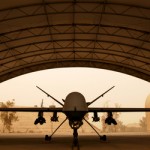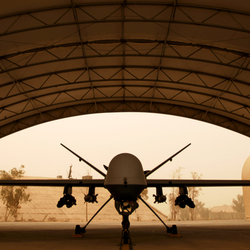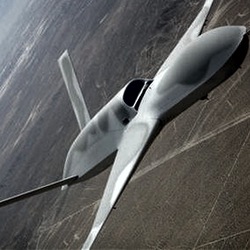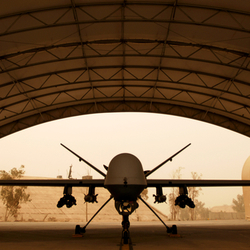 Artificial intelligence has not yet reached a level that allows for a truly autonomous robot, but we have come far in the last 50 years. Robots are in use today, performing duties from vacuuming our floors to building cars, to fighting our wars for us. Only a handful of these machines possess any degree of autonomy, and even fewer of those (thankfully) are armed. The United States military stables the greatest arsenal of armed robots in the world, and has several major companies spearheading the advanced robotics research and development industry, with the singular stated goal of creating a better war machine. Because of this, more funding is moved each year into projects to develop new drones for military use, roboticise existing military hardware, or weaponize commercially available robotics.
Artificial intelligence has not yet reached a level that allows for a truly autonomous robot, but we have come far in the last 50 years. Robots are in use today, performing duties from vacuuming our floors to building cars, to fighting our wars for us. Only a handful of these machines possess any degree of autonomy, and even fewer of those (thankfully) are armed. The United States military stables the greatest arsenal of armed robots in the world, and has several major companies spearheading the advanced robotics research and development industry, with the singular stated goal of creating a better war machine. Because of this, more funding is moved each year into projects to develop new drones for military use, roboticise existing military hardware, or weaponize commercially available robotics.
With public disapproval of any armed conflict on the rise, the DoD is under heavy pressure to remove the human element from the equation in order to reduce American casualties. Costs involved in the development and deployment of manned aerial weapons systems alone have skyrocketed beyond the allotted budget, largely due to physical restraints of such advanced systems that remain tied to and must facilitate biological constraints. The best example of this phenomenon would be the costly development of the F-22 Raptor. Years of delays along with constant budgetary overruns plagued the project to the point that it nearly failed. The end result is a plane that costs $361 million, whereas an unmanned drone could be purchased for a fraction of that cost, and no pilot would require costly flight-time.
These 12 machines were purpose-built to kill and destroy while saving friendly civilians. It may be an ugly idea, but it works.
MQ-9 Reaper (aka Predator B)

Beginning life as a simple Predator unmanned attack-drone, the MQ-9 Reaper has taken its place in an ever-growing fleet of “hunter-killer” robotic aircraft currently in use. The Reaper’s greatest upgrade from the Predator baseline series is in its turboprop engine, with nearly nine times the horsepower of the original piston-driven power-plant. That equates in the field to being able to carry 15 times the load of ordinance, as well as being able to move three times faster than the now sluggish Predators. It’s capable of deploying laser-guided bombs and Hellfire missiles against ground targets, with deadly precision. Technically it’s also capable and tested to use air-to-air missiles against aerial targets, but that real-life scenario hasn’t come up yet. Able to carry a maximum payload of 3,000 lbs to a considerable ceiling of 52,000 ft., it can remain aloft for 36 hours. The Reaper is fully capable of autonomous operation.
Predator C “Avenger”

The General Atomics Avenger is not a bad super hero out of the 80’s, but a super-sized, heavily upgraded member of the Predator family of armed UAV’s. This one’s more commonly known as the Predator C, making it the last installment of the series. It’s nearing the end of its developmental stage and aside from its namesake has little in common with its predecessors, and is actually similar in some ways to the new Air Force’s new F-22 Raptor. It’s built to utilize the same weaponry as the Reaper, but has a far different method to its mayhem; the Avenger uses a stealth-designed jet engine. With an operational ceiling of 60,000 ft., it can hang with the likes of U-2 spy planes. Flying at 400 knots for 20 hours, it can haul 3,000 lbs of munitions to lay on target. The Avenger is capable of autonomous operations


